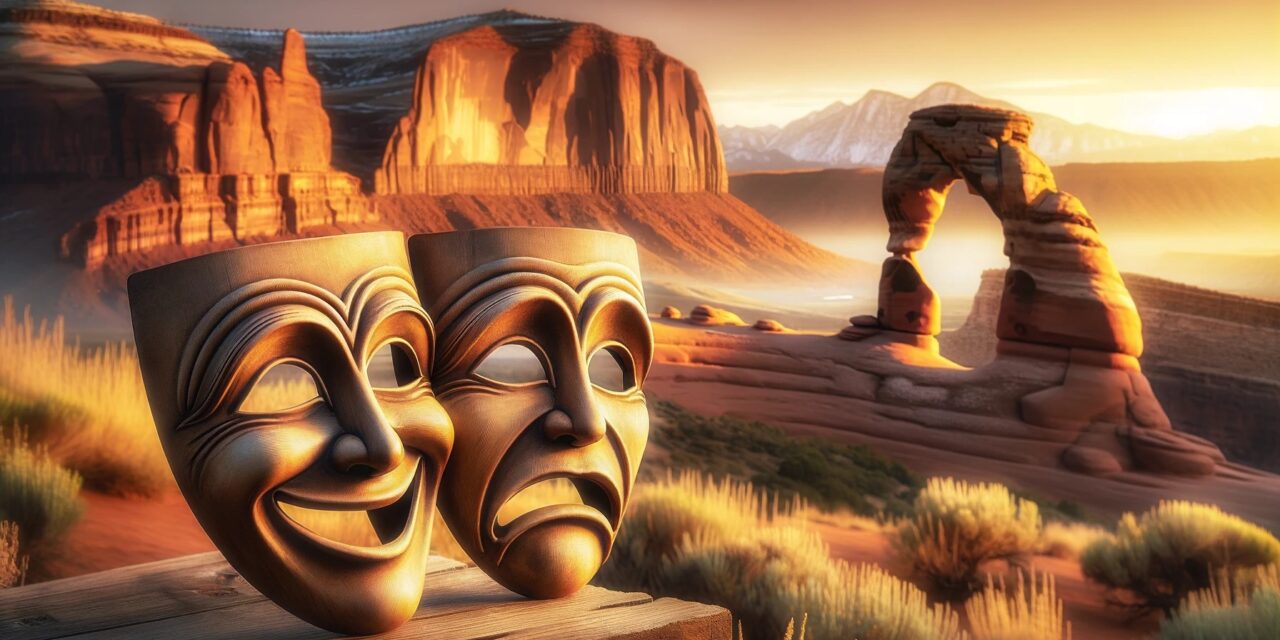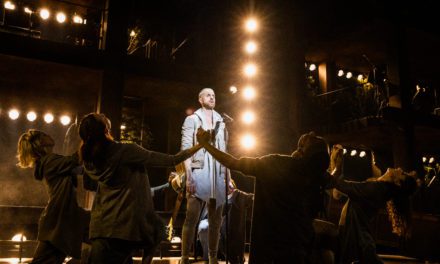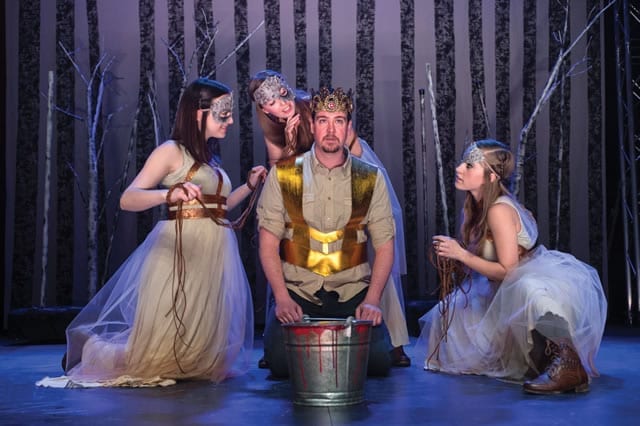SANDY — Arriving at Hale Centre Theatre on November 13 with great anticipation to see the beloved Disney musical Beauty and the Beast, my niece and I were informed that the show, on the third day of scheduled performances, had not yet opened because “the show isn’t ready yet.” We were given tickets for November 23, and went in with with more tempered expectations—an appropriate mental state because what we were about to experience was a production that left both of us disappointed.
Sitting through Hale’s Beauty and the Beast is like spending 2 hours trying to keep track of the moving staircases at Hogwarts. Enormous sets are constantly rising, falling and spinning, and all kinds of things flying through the air adding to the chaos.
Whatever the reason for the delay of the show’s opening, the production still had significant technical problems, not to mention more than its share of head-scratching set design, props and costume choices by the production team.
The production is dominated, not by the spunky spirit of Belle or a scary-turned-sensitive Beast, but by set designer Nate Bertone’s grand castle set piece that spins up from the ground. Its reveal is a memorable moment for sure, and echoed by the massive multi-tiered cake which similarly emerges from the pit for “Be Our Guest”.
However, these gigantic set pieces created issues that sabotaged the performance. The three-level castle, packed with pillars and stairs, blocked the view of the on-stage performers, especially for patrons on the lower seating levels. The sets also greatly limited choreographer Afton Wilson because the actors only had space for small, stilted motions. The mob ensemble in the “Kill the Beast” number was given the best dance number simply because the choreographer and dancers had ample room to maneuver.
The visual elements of this production overwhelm the original music, lyrics and book—by Alan Menken, Howard Ashman and Tim Rice, and Linda Woolverton, respectively—and tower over the performances of the actors, too. It speaks to the strength of the actors that they can keep up and still hit their marks in a tech-heavy show like this, and the minor characters and chorus performed very well. But the production design seemed to keep the audience from emotionally connecting with the story and characters, instead distracting them with one spectacle after another.
Shae Robins had a strong first act as Belle, with good expression, movement and musical theater voice; she provided an emotional core which carried the audience to intermission. After intermission, Robins’ lines became less natural and more sing-songy, which lessened the dramatic power of Belle’s character growth and romantic love in the second half.
While the production’s treatment of most characters was consistent with tradition and audience expectations, Hale’s Beast was childish and not intimidating, with a high tenor speaking voice. Perhaps this indicates that he never grew from child to man. However, why then do the growl sound effects sound like they belong to the other Beasts we’ve seen before—deep and ferocious?
Costume Jenn Taylor also made the curious choice to mismatch his clothed and unclothed areas. The Beast’s tunic and trousers and close-fitting, like a typical man. This juxtaposed poorly with a huge bushy tail, enormous padded slippers, big furry hands, and gigantic headpiece capped with a ridiculous pompadour (my word, the pompadours in this show). It appears that only the exposed areas of him turned into a Beast; there is simply no way any fur or beastliness could exist under that clothing.
Darick Pead, who plays the Beast, is a fine singer and actor, and his physical performance of the role was appropriate—he hunches, lurches and moves like a half-animal. However, the combination of his performance and the character’s costume don’t seem to command the gravitas that the role requires. It’s surprising that the production decided to lean into the whiny teenager nature of the spoiled prince, and leave the Beast behind.
For most of the performance, Beast wore a large, solid prosthetic mask with fangs. While certainly not ideal since the chin didn’t move at all with speech, it seemed okay. For the scene of Beast’s climatic transformation, however, his voice was pre-recorded, so I anticipated a magical transformation using this new, special mask. Unfortunately, the transformation consisted of the auditorium going completely black for several seconds during which the change happened (my niece reports she saw the mask thrown off-stage). It is shocking that a theater with Hale’s resources could not find a solution to portray the transformation in a satisfying fashion. This is supposed to be the dramatic conclusion of the show; talk about killing the energy.
Other technical failures and questionable choices marred the production. Most egregiously, all the petals of the enchanted rose dropped at once early in the production. “Surely, they’ll fix it during intermission,” I thought. Wrong. Because the rose is attached to a giant robot set piece, it is actually stored in an upside down angle which likely made it impossible to reset without descending the arm and doing so in front of the entire audience (which they chose not to do). So for the entire show, the rose was naked, undercutting a critical element of the story.
Chip, played by Link Evans and Mason Burnham, is an exposed head popping out of a wheeled trolley. While this portrayal has been done in other productions, it does seem to severely limit the ability of the actor to express himself and develop a character. It also doesn’t appear to hold up to the premise that the characters are gradually transforming since all the other characters still have bodies.
Other curious choices involved giving all the dancers for “Be Our Guest” confetti guns that looked like they had been welded at a high school shop class. Why shackle performers with such things and limit the visual and dancing potential of the iconic song instead of simply releasing confetti above the audience? And given the opulent set pieces that dominated the production, the curiously lightweight library set was incompatible with Belle’s declaration that she’d “never seen anything like it.”
Among the rest of the cast, Kyle Baugh stood out as Cogsworth and displayed fine comedic timing, delivery and character work. He inhabited the role naturally, and his performance gave the castle scenes a more grounded male presence than the petulant Beast or dandy Lumiere played by David Paul Smith. Preston Yates’ Gaston sounded exactly like Chris Pine in the “Into the Woods” film — derivative, perhaps, but not a bad thing — and the character had quality moments, like when he did bicep curls with Belle.
In the end, however, Hale’s production is more “Beast” than “Beauty”—with an overwrought production design, mismatched Beast, technical failures, and odd design choices. While the production has many strengths and good performances, its dedication to elaborate design overwhelms and sabotages the talent of the actors onstage. At Hale Centre Theatre, it’s expected that the tech will always have the last bow. This time, it fell on its face.
*Opening production was delayed from November 11 to November 16, 2024

These reviews are made possible by a grant from the Salt Lake County Zoo, Arts, and Parks program.




